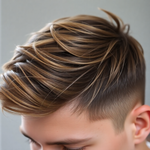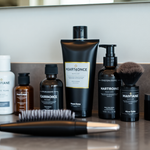
Semi‑Permanent Hair Color as a Color‑Coding System: How to Cut Clothing Waste in a Men's Capsule Wardrobe
17 September 2025
Share
Semi‑Permanent Hair Color as a Color‑Coding System: How to Cut Clothing Waste in a Men's Capsule Wardrobe
Intro: A small change that clears your closet and your head
Struggling to look sharp without drowning in clothes you never wear? Semi‑Permanent Hair Color as a Color‑Coding System can be a fast, low-risk way to create visual cohesion across your closet, reduce impulse buys, and seriously cut clothing waste in a men's capsule wardrobe. Start with one subtle hair anchor and you ll turn a messy wardrobe into a tight, wearable collection that actually gets used.
Why a hair-based color code works
Most guys pick clothes by habit, mood, or a single trend — which leads to overlap, forgotten pieces, and a tendency to replace rather than repair. Using semi-permanent hair color as a consistent visual anchor changes that. It provides a daily, unmistakable cue that tells your eye what belongs together. That clarity reduces decision fatigue in the morning and reduces the number of unnecessary purchases that create textile waste.
Semi‑Permanent Hair Color as a Color‑Coding System: the core idea
Here s the practical definition: pick a semi‑permanent hair shade that becomes your wardrobe s unofficial accent color. Your core wardrobe remains neutral and versatile; your hair tone adds a repeatable pop that connects outfits. Because semi‑permanent dyes fade gradually and are gentler on hair, the commitment level is low and the environmental impact is smaller than frequent full permanent changes.
Who this is for
- Men aged 18–45 who want a smarter capsule wardrobe without buying more stuff.
- Anyone interested in reducing clothing waste and improving cost-per-wear.
- Guys who want a simple grooming habit that improves outfit consistency.
Step‑by‑step: set up your hair color coding system
- Decide your anchor tone: Pick a tone that reads as natural: warm chestnut, ash brown, soft black, muted copper, or deep blue-black. Avoid extreme neon shades unless that s your whole brand — neutrals mix easier.
- Audit your closet: Spend 30–60 minutes pulling everything out. Sort items into: 'Works with anchor' and 'Doesn't work.' Be ruthless with anything you haven t worn in 12 months.
- Create a 10–15 piece capsule: Choose core pieces in neutrals (navy, gray, white, olive, tan). Add 2–3 pieces that echo your hair anchor (e.g., rust tee for copper hair, deep-olive knit for warm-brown hair).
- Limit new purchases: For 90 days, buy only pieces that match your anchor or repair/re-style existing items. This trains you to buy with intention and cuts impulse waste.
- Schedule upkeep: Semi‑permanent touch-ups every 4–8 weeks keep the anchor clear. Fading can be used strategically as a seasonal shift.
Choosing the right shade for your skin tone and wardrobe
Color theory matters. Match undertones — warm hair looks best with warm clothing tones; cool hair pairs with cool palettes. If you re not sure, a barber or colorist can recommend an anchor that reads natural in daylight and photos. Pick a slightly muted version of your desired color so it s noticeable without screaming for attention.
Design rules for a capsule that respects your hair
- Keep 60–70% of your wardrobe in core neutrals that work with any anchor.
- Reserve 20–30% for anchor-friendly accents: shirts, beanies, scarves, or shoes that repeat the hair tone.
- Allow 10% for statement pieces that don t need to match — these are your wildcards for dates or special events.
How the system cuts clothing waste (the mechanics)
There are three practical ways this method reduces waste:
- Better decision-making: You buy fewer items that don t mix, so fewer pieces get tossed or donated.
- Higher utilization: A coordinated closet means you wear more of what you own, increasing cost-per-wear and stretching garment lifecycles.
- More repairs and fewer replacements: When your wardrobe is intentional, you prioritize mending a favorite piece over replacing it, cutting lifecycle waste.
Maintenance: hair, clothes, and routine
Small routines keep this system working:
- Touch up semi‑permanent color every month or as it fades to keep the anchor visible.
- Set a quarterly wardrobe check: mend, re-tailor, or donate items that don t match the anchor system.
- Rotate shoes and outerwear to reduce wear concentration; this extends life and reduces replacements.
Cost and value: math that makes sense
Think in cost-per-wear. A single well-chosen jacket that coordinates with your hair anchor will be worn more months out of the year than five trend jackets that clash. Paying a little more up-front for quality and versatility lowers your long-term spend and the number of garments entering the waste stream.
Real-world story: Tom's 90‑day experiment
Meet Tom, 29, junior architect. He had a closet full of acquisitions and little cohesion. He chose a muted copper semi‑permanent dye, pared his closet to a 12-piece capsule, and added two copper-accented shirts. In three months he stopped buying random tees and fixed two favorite jackets instead of replacing them. His cost-per-wear rose and he reported less closet anxiety. The hair anchor helped him see gaps clearly — so his purchases became targeted, not emotional.
Seasonal tweaks and flexibility
Your anchor can play with seasons. Let it fade slightly in summer for a lighter palette and refresh for fall to match warmer layers. This creates a natural rhythm to buying: you only buy seasonal pieces that work with the anchor, which reduces binge buying after the season ends.
Visuals, images, and accessibility (how to present this online)
- Use photos showing the hair anchor paired with core outfit sets. Caption: 'Anchor shade paired with capsule essentials.'
- Create a simple infographic that maps anchor color to 6 wardrobe pieces.
- Alt text example: 'Man with chestnut hair wearing navy blazer and tan boots, demonstrating hair-based color coordination.'
Where to get semi‑permanent color and what to ask
Choose ammonia-free, low-damage formulas or visit a barber who uses professional products. When you consult, ask: 'How will this shade look under daylight and in photos?' and 'How long before this will need a refresh?' A short salon consult avoids mistakes and gets you the exact anchor you want.
Common objections and quick responses
- "I don t want to look fake" — Pick muted, natural tones that enhance, not dramatize. Semi‑permanent dyes are subtle and fade gracefully.
- "Too much upkeep" — Touch-ups are brief. A 20–30 minute session every 4–8 weeks keeps the system consistent.
- "I like variety" — Use the anchor for weekdays and keep 1–2 rotation wildcards for weekend experimentation.
Quick wardrobe audit checklist (printable)
- Pull everything out of the closet.
- Sort: 'Works with anchor' / 'Doesn't work'.
- Donate/sell items not worn in 12 months from 'Doesn't work'.
- Identify 1–2 gaps to fill intentionally (not more).
- Schedule any repairs and plan one hair refresh date.
Resources and credibility
Textile waste is a real issue — organizations like the EPA track how clothing contributes to landfill mass and encourage reuse and repair as mitigation strategies. For more on the environmental stakes, see the EPA's textile data here.
How Menll.com fits in
If you re building a capsule around a hair anchor, pick versatile, durable pieces. Menll.com s EcoSneak Casual Shoes are a good example of a neutral, sustainably-minded item that pairs with many hair anchors. Explore capsule-friendly layers like their outerwear collection for minimalist, long-lasting pieces: Menll.com outerwear. For guidance on building a capsule, check this helpful Menll.com blog post: How to Build a Capsule Wardrobe.
30‑day challenge: test the system
Try this 30‑day pilot:
- Choose a subtle semi‑permanent anchor and book a touch-up date.
- Audit your closet and build a 12-piece capsule.
- Wear only capsule pieces for 30 days, repair instead of replacing.
- Track purchases: aim for zero non-essential buys.
- At day 30, reassess: did you buy less? Feel less closet stress? If yes, scale up.
FAQ
- Will this work for all hair types? Yes — semi‑permanent formulas suit most hair textures. A salon consult helps nail the shade.
- Can I still wear prints and colors? Of course. Use prints as your statements; your hair anchor ties them to the rest of the capsule.
- Is this sustainable? It s a behavioral tool. The environmental benefit comes from fewer purchases, more repairs, and longer garment life.
Final notes and a simple promise
Semi‑Permanent Hair Color as a Color‑Coding System is a low-effort, high-return way to organize your closet, reduce waste, and look sharper with less hassle. It s not about forcing a look — it s about introducing one consistent visual cue that makes everything else fall into place.
Ready to try it? Pick a subtle anchor, audit your wardrobe, and commit to one intentional buy. Tell us how it goes — which anchor would you try? Comment below or browse Menll.com for capsule-friendly pieces and sustainable options.
Prev post

Semi‑Permanent Hair Color: Coordinate, Don't Buy — Build a Sustainable Men's Capsule Wardrobe
Updated on 18 September 2025
Next post

Shade Rotation System: Using Semi‑Permanent Hair Color to Maximize a Sustainable Men's Capsule Wardrobe
Updated on 16 September 2025





